Share
How to Fail as a Surf Photographer
A note about waves: When waves are crashing, the ocean floor is often nearby. This has to do with physics (friction caused by the seabed causes the...
A note about waves:
When waves are crashing, the ocean floor is often nearby. This has to do with physics (friction caused by the seabed causes the velocity of the bottom to slow relative to the top), but the real life application is that one who has lived on the east coast for 20 years should enter the water with trepidation, or alternately should value his life a little less.
And now I know.
Back in January, I rented an Ewa Marine bag, and tried to shoot surfing with limited success. This month, I was back in Hawai’i, and rented an SPL aluminum housing for my D3s from HawaiiCamera.com, which is still the best camera store in Honolulu (check out their new Maui location too). I was determined to get a few good shots of people in the ocean even though 1) I don’t surf, 2) I get sea sick, 3) I am no Michael Phelps in the water.
But before you laugh at my aquatic disposition, I’ll let you know that I started off with baby steps — joining my friend Bob and his family at Waimanalo Beach, where the waves could best be characterized as “small.”

Bob catches a wave at Waimanalo Beach Park
The nice thing about Waimanalo is that no one is going to get hurt (unless you get stung by a Portuguese Man-o-war). The seafloor is sandy and hospitable, the waves rarely exceed 1-2 feet, and the shore break is kind and forgiving. Bob and I used to boogie board here during high school.
The SPL housing snugly holds the D3s, and only has controls for aperture and shutter speed. Sounds like enough, but it really isn’t. You have to think about ISO, shutter mode, focus mode, focus pattern, etc — and it really sucks to forget to set (or forget if you set) these parameters. I was constantly twisting off the wingnuts that hold the lens port atop the body casing to verify my settings — and you can’t really do this around sand as a little grain of sand is the most likely cause of a leak.
Here are my settings:
- ISO 800
- f/8
- aperture priority
- continuous focus
- 51-point focusing
- continuous shutter (high — 9fps)
- 24-70mm f/2.8 at 24mm
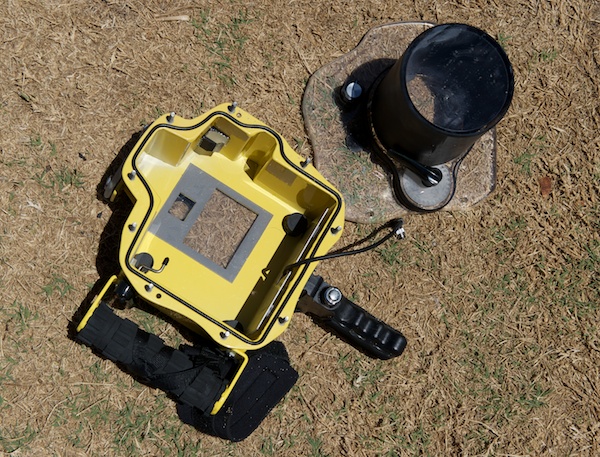
And off I went.
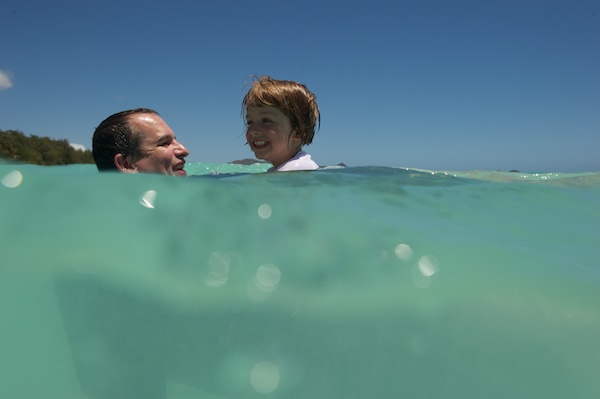

When you are not battling the conditions, it’s easy to get a false sense of security. I could touch the bottom of the ocean at all times, there were no rocks, the waves were small, I was photographing Bob and his kids. It was just enough to make me think, “This ain’t so hard.”
So after a plate lunch and shave ice, I headed over to Makapu’u, which is a popular spot for boogie boarding, where the waves aren’t typically characterized as “small.” I forgot to bring my fins, but dove in anyway thinking that fins couldn’t possibly be *that* big a deal.
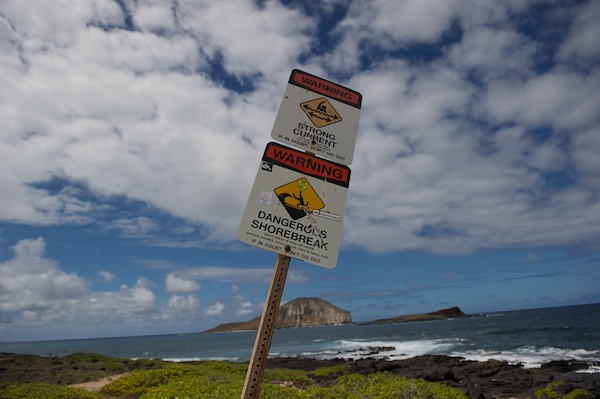
The permanent signage at Makapu’u. “If in doubt, don’t go out.”
This would be an opportune moment to quote surf photographer and North Shore native Clark Little who was interviewed by Gizmodo last year:
Gizmodo: You’re wearing fins?
Clark: Yeah you’re wearing fins for sure. That’s my life vest to be honest. I wouldn’t go anywhere without swim fins.
Bob sent me the interview after I nearly drowned at Makapu’u (I kid, I’m sure the lifeguards would have saved me). After about 10 minutes struggling in the water, I decided I had had enough for the day.
While I was surfing the web at my parents home, I came across the underwater photography of Kurt Chambers, who is a world class freediver. Kurt can apparently hold his breath for 7 minutes. I mean if David Blaine can hold his breath in a tank, stand on a pole for two days, and chill in a block of ice, then clearly I can take a few underwater photos.
So I emailed one of Kurt’s collaborators, Alicia, and met her at Electric Beach in Nanakuli. We staked out the location, and I feigned confidence. As we approached the water sans fins (again), Alicia looked at me and said, “You didn’t bring a mask?”
“Er, no.”
“Wait here. I have an extra one in my car. It’ll make it much easier.”
She returned with mask in hand, and we entered the clear water. I fired off a few frames near the surface, then confidently told her that I would dive under her and shoot up. She nodded her head in acknowledgment and added, “Don’t drown.”
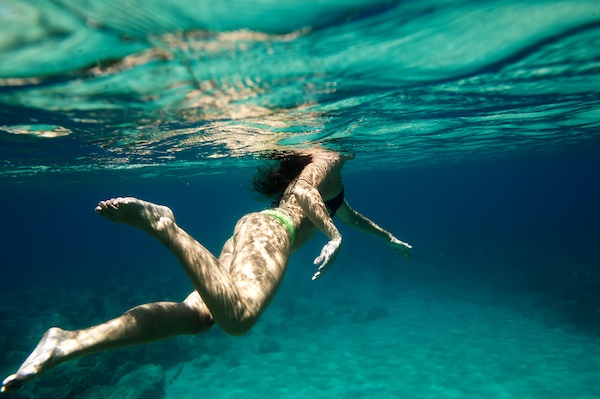
I aimed my body in the direction of the ocean floor (depth: 10 feet), and started kicking to go down. Unfortunately for me, the SPL housing floats, which means more energy was needed to go down than I possessed. I made it down near the bottom and started to shoot through a mask that was filling up with water, when I started to feel that burning sensation in my lungs that reminded me how much I love oxygen.
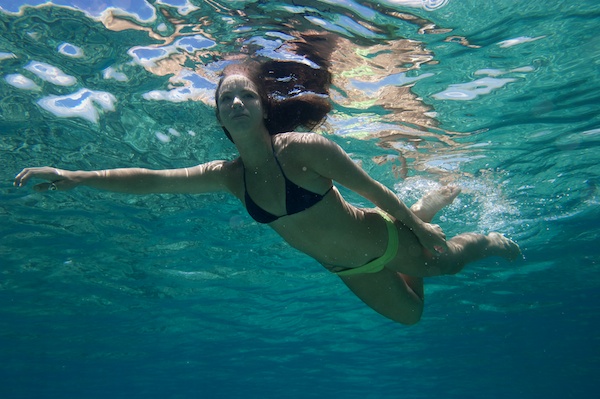
I must have been down for at least 8 seconds, and by the time my head emerged again from the water, I felt like I was going to pass out. Eight seconds vs. seven minutes. Alicia said that Kurt told her to dunk her face into a bowl of ice water to combat the panic sensation and train yourself for freediving. I opted for the slurpee from 7Eleven.
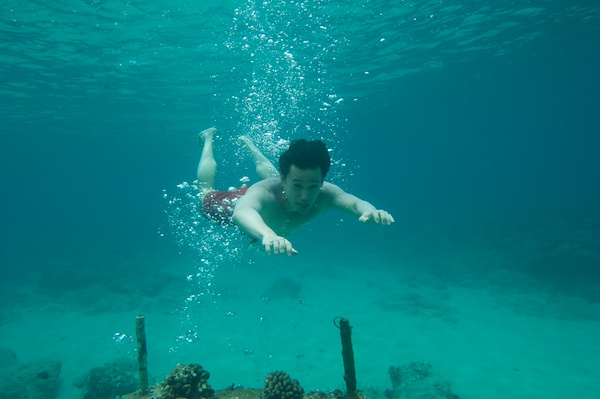
Alicia took a photo of me as proof that she is far more adept at underwater photography
A few days later, I was back at Makapu’u with fins. My confidence was high. I was moving fast in the water. I seemed to have the respect (or the curiosity) of the wave riders. I told them to aim for me — they really need to be absurdly close to you when you’re at 24mm. I sprayed and prayed, and after about an hour, I came out of the water unscathed, confident that I had obtained a few shots.

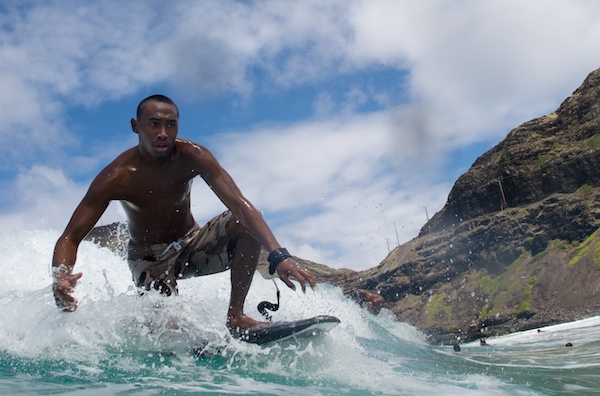
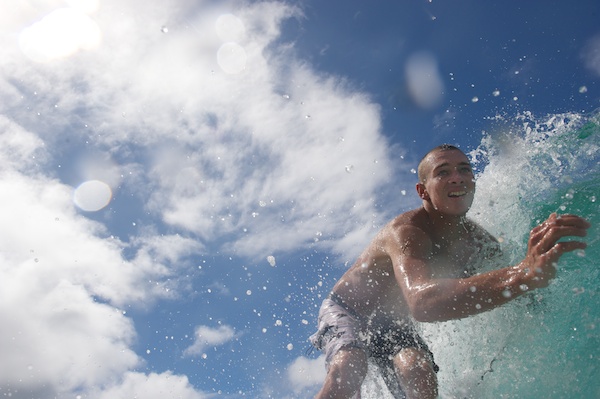
I jumped in my car, and headed home, and at the last minute, decided to stop at Sandy’s. Sandy’s is another beach that I’m pretty familiar with. Great beach, cute girls, and as the lifeguards like to announce over the bullhorn with regular frequency “we have a disproportionate number of neck and back injuries at this beach. Don’t enter the water if you don’t know what you’re doing.”
Hello? I just owned Makapu’u. And clearly a dude with an underwater housing knows what he’s doing…
So it was back in the water, and off to the left because that’s where all the boogie boarders were hanging. Most of the wave action occurs at the shore break, you can’t ride a shore break, and that’s why all the real boogie boarders hang to the left and far off shore. But what exactly is causing the waves to break to the left and off shore?
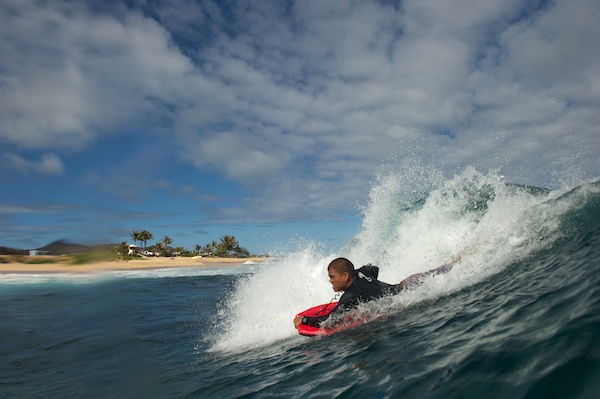
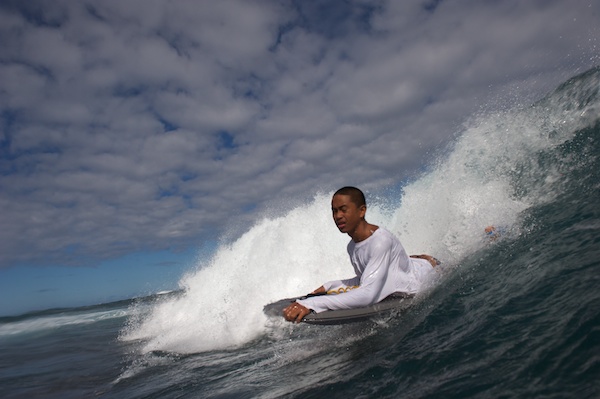
Truth be told, I kind of knew. It’s the rocks and reef. You know, the shallow rocks and reef that causes friction on the bottom of the wave, which in turns leads to the break. I was doing fine until the kid in the white t-shirt. That’s when a wave crashed on me and I lost a fin, and then started to tumble underwater. And as I tumbled I saw up close how shallow and rocky the beach really was. I pushed my hands out to try to prevent becoming a statistic, and after what seemed like forever, I tumbled onto the shore, found my missing fin, and pretended everything was cool.
And despite all the tossing and turning, I felt exhilarated by the end. I finally felt like I got it. I’m not Waimea Bay at Christmas-ready, but I felt like all the little lessons had been learned, and I could finally start worrying less about the technical stuff, and more about just capturing some good images. I can also definitely say that being in the water beats the heck out of standing on the sand with some long glass trying to capture some pics. I acknowledge that I didn’t actually photograph any surfers, but that was by design. By this point, I realize what an amateur I really am, and being hit by the foam of a boogie board surely beats the sensation of a fiberglass bullet running into your head.
In December, I shall return home, and rent that SPL housing once again. And I will try to make better pictures, visit by visit. If you find my fin in the water, please be kind, and retrieve it for me. I’ll need it.


